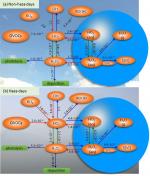Citation:

摘要:
Field measurements of atmospheric peroxides were obtained during the summer on two consecutive years over urban Beijing, which highlighted the impacts of aerosols on the chemistry of peroxide compounds and hydroperoxyl radicals (HO2). The major peroxides were determined to be hydrogen peroxide (H2O2), methyl hydroperoxide (MHP), and peroxyacetic acid (PAA). A negative correlation was found between H2O2 and PAA in rainwater, providing evidence for a conversion between H2O2 and PAA in the aqueous phase. A standard gas phase chemistry model based on the NCAR Master Mechanism provided a good reproduction of the observed H2O2 profile on non-haze days but greatly overpredicted the H2O2 level on haze days. We attribute this overprediction to the reactive uptake of HO2 by the aerosols, since there was greatly enhanced aerosol loading and aerosol liquid water content on haze days. The discrepancy between the observed and modeled H2O2 can be diminished by adding to the model a newly proposed transition metal ion catalytic mechanism of HO2 in aqueous aerosols. This confirms the importance of the aerosol uptake of HO2 and the subsequent aqueous phase reactions in the reduction of H2O2. The closure of HO2 and H2O2 between the gas and aerosol phases suggests that the aerosols do not have a net reactive uptake of H2O2, because the conversion of HO2 to H2O2 on aerosols compensates for the H2O2 loss. Laboratory studies for the aerosol uptake of H2O2 in the presence of HO2 are urgently required to better understand the aerosol uptake of H2O2 in the real atmosphere.